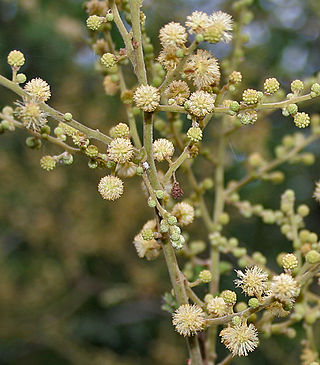Top Qs
Timeline
Chat
Perspective
Vachellia leucophloea
Species of legume From Wikipedia, the free encyclopedia
Remove ads
Vachellia leucophloea (Hindi: रेवंजा, romanized: pa, lit. 'ਰੇਰੂ'), also vernacularly as the White Bark Acacia or reonja, is a moderate-sized tree native to South and Southeast Asia.[1][2]
Remove ads
Distribution
Vachellia leucophloea grows natively in India, Nepal, Pakistan, Sri Lanka, Myanmar, Thailand, Vietnam, and Indonesia.[1]
Medicinal uses
The bark extracts of Vachellia leucophloea are used in Pakistani traditional medicine as an astringent, a bitter, a thermogenic, a styptic, a preventive of infections, an anthelmintic, a vulnerary, a demulcent, an expectorant, an antipyretic, an antidote for snake bites and in the treatment of bronchitis, cough, vomiting, wounds, ulcers, diarrhea, dysentery, internal and external hemorrhages, dental caries, stomatitis, and intermittent fevers and skin diseases.[3] An ethanolic extract ointment has shown marked wound healing activity in trials.[4]
Remove ads
Culinary uses
The bark is used to prepare a spirit from sugar and palm juice, and in times of scarcity it is ground and mixed with flour. The pods are used as a vegetable, and the seeds can be ground and mixed with flour.[5]
Other uses
The wood is sometimes used to make attractive furniture and other implements, though it can be difficult to work with and is not durable.[6]
References
Wikiwand - on
Seamless Wikipedia browsing. On steroids.
Remove ads

